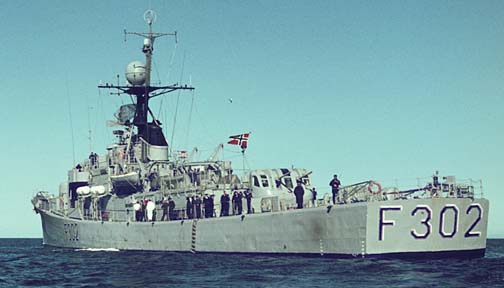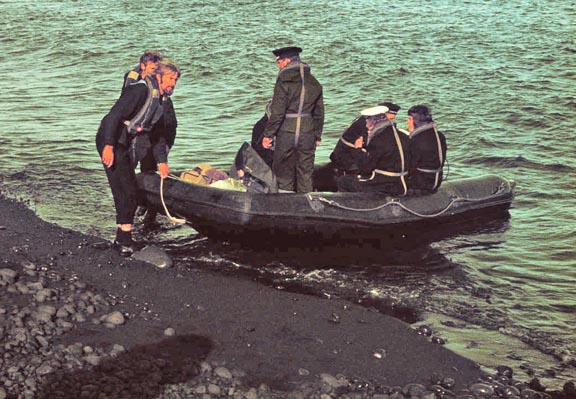Getting There is Half the Fun: Voyage to Jan Mayen, August 1973
Following the unexpected eruption of Beerenberg on
Jan Mayen in September, 1970, and the consequent emergency evacuation
of weather and navigation station personnel from that remote island,
the Seismological Observatory at the University of
Bergen, Norway, assumed the task of developing a seismic and volcanic
activity warning system. I
was an invited consultant because of my volcano monitoring experiences
in Hawaii. Together with the Norwegian Defense Department, Observatory
staff designed a seismic refraction experiment to detect the locations
and sizes of possible magma chambers beneath the island. Primary seismograph
stations were established at the middle and each end of the island together
with a patterned array of sonobuoys at sea to record shocks generated
by 25 depth charges shot from two Royal Norwegian Naval frigates, the
KNM 'Trondheim' and the KNM 'Stavanger', as they cruised
around the island.
We departed on the 'Trondheim' for Jan Mayen from Tromsö
in northern Norway on 13 August 1973 into the face of what the Norwegian
Navy termed a "small storm."
Now a frigate is warship built for speed, not stability, especially
in such a storm that not only produced waves high and strong enough
to sweep over the bow and break windows in the forward cannon of the
'Trondheim', but also forced half its crew and me to huddle
below decks in our bunks, seasick for three days. Although mid-August,
it was hardly "your basic summer cruise!"
But once we arrived at Jan Mayen, the weather miraculously cleared,
the gale winds ceased, and bright sunshine allowed shirtsleeve working.
During the seismic shooting, two of us camped at the north end of the
island with a seismograph and the technician's two big dogs. On our
second day, which was just beautiful by all Jan Mayen standards, the
project chief and I took a memorable
day hike up the flank of Beerenberg to the 1970 eruption area. It
is a trackless, lava-covered 'moonscape' lacking any vegetation whatsoever,
and is seldom, if ever, seen or visited by anything except by multitudes
of birds and rare hikers wanting to reach Beerenberg's summit. Several
fumaroles were actively steaming, and the whole area looked as though
the eruption had happened only yesterday instead of three years before.
What a geologic adventure to hike over such youthful lava flows and
cinder cones and to imagine their fiery formation! After such a glorious hike, a swim was certainly in order, so I stripped down, but just as quickly as I jumped into the sea, I jumped back out. Several of the 'Trondheim's' crew stood giggling on the shore; not one followed me into the sea, perhaps because the sea temperature was just 3° Celsius. What a shock! Brrrrr!
Due to an unfortunate recording error, the seismic refraction
experiment was only marginally successful in inferring the presence
of three possible magma chambers, of which the one beneath Beerenberg
may have supplied the magma for a two-day eruption in 1985, also 30
km from the weather and navigation station. That eruption gave as little
warning to the island's personnel as the one in 1970, but the experience
gained in 1970 obviated another difficult and costly evacuation in 1985.
|
Return to Home Page | Return to Gallery Page | Top of Page

